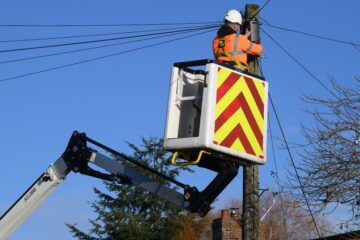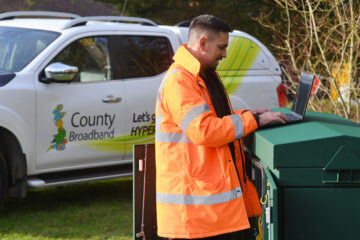Full fibre broadband has been the leading force for digital connectivity for both present and future technology for some time now. As of summer 2023, Ofcom reported that 52% of UK premises were covered by full fibre, while a further 75% were in reach of gigabit-capable networks.
These figures are ever-increasing as people and businesses continue to digitally futureproof themselves with full fibre broadband. With plenty of people making the switch, or even just considering it, this naturally leads to frequently asked questions on what full fibre really is, what the benefits are, and how you can get connected.
We’re putting curiosity to rest and answering the most common queries made when switching to full fibre broadband.
What is full fibre? / FTTP vs FTTC – what’s the difference?

Simply put, full fibre is a type of broadband that utilises fibre-optic cables to carry your data around the network. It does this by pulsing light down glass cables no wider than a hair or ‘fibre’.
These pulses of light carry your data faster than you can imagine and provide you with a robust connection for whatever task you may require, from 4k streaming and gaming to video banking and staying in touch with loved ones with confidence.
In your research of full fibre, you may have seen various acronyms like FTTC and FTTP; but what are they? These translate to Fibre-To-The-Cabinet (FTTC) and Fibre-To-The-Premise (FTTP).
‘Superfast’ broadband, which currently covers the majority of the UK, uses the former, FTTC, to carry data. This works by using fibre cables to connect to the ‘green cabinets’ commonly found on your street corners and then relying on copper cables the remainder of the distance to your premise.
FTTP, meanwhile, exclusively uses fibre-optic cables to your property; hence the name ‘full fibre’. This is why Superfast networks are unable to match the speeds of full fibre as copper cables are simply unable to carry large amounts of data at the speeds needed to keep up with the technology of today and beyond.
What are the benefits of full fibre?

Now you’ve got the terminology down, what does this all mean for day-to-day use? Are the benefits really worth switching for? In short, yes.
Full fibre boasts speeds which are a whopping 11x faster than Superfast, copper-based networks, and can achieve speeds up to 1,000 Mbps which can be upgraded to 10,000 Mbps and beyond in the future.
This means huge multi-device connectivity with up to six devices streaming ultra-HD video simultaneously, and lightning-fast downloads able to save a full-HD feature-length film in four minutes. Pair this with crystal-clear video-conferencing for the home office, and rock-solid connections for intense online gaming, switching to full fibre is a no-brainer.
Plus, as our technology becomes ever-demanding and data-hungry, the need for full fibre will only become more apparent.
What broadband speed do I need for streaming and gaming?

We offer a wide range of full fibre packages, carefully curated to each premises’ needs. As a general rule of thumb, you’ll want to increase your average speed – represented by Megabytes per second or Mbps – depending on how often you’re streaming or gaming, how many people are online at the same time, how many rooms are in the house, and so on.
With so many variables, the easiest way to find the right broadband package is to use our ‘Which Speed Quiz’ – a short questionnaire that looks at how you use your broadband in order to calculate the most suitable speeds for your needs, be it for the home, or business!
How easy is it to switch to full fibre?

Making the switch isn’t the arduous chore it’s made out to be. You can easily check if we’re already building in your village via our handy postcode checker, or look out for our village meetings (held in-person and online) or the friendly faces of our sales team who can help you upgrade from your doorstep.
Plus, as a community provider connecting villages across rural hard-to-reach areas of the East of England, our teams are always on hand to support customers from the first point of contact, right through to installation and maintenance.
Is full fibre available near me?

If you live in a particular rural area you may assume that you may be missed as part of the widely reported ‘postcode lottery’ but you would be mistaken.
We put an emphasis on connecting rural, hard-to-reach communities across the region and even have a dedicated team for premises that require specific work to be connected like farms and other remote buildings.
Whether you’re a resident or business, you can check if you’re covered in County Broadband’s rollout by entering your postcode at www.countybroadband.co.uk where you can also register your interest in finding out more about the infrastructure and service.






